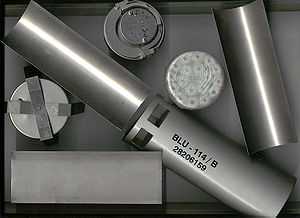Graphite bomb

A graphite bomb (also known as the "Blackout Bomb" or the "Soft Bomb") is a non-lethal weapon used to disable electrical power systems. Graphite bombs work by spreading a cloud of extremely fine, chemically treated carbon filaments over electrical components, causing a short-circuit and a disruption of the electrical supply. The filaments are only a few hundredths of an inch thick and can float in the air like a dense cloud. The weapon is sometimes referred to as a "soft bomb", since its effects are largely confined to the targeted electrical power facility, with minimal risk of collateral damage.
The graphite bomb was first used against Iraq in the Gulf War (1990–1991), knocking out 85% of the electrical supply. Similarly, the BLU-114/B "Soft-Bomb" graphite bomb was used by NATO against Serbia in May 1999, disabling 70% of that country's power grid. After initial success in disabling Serbian electric power systems, the electric supply was restored in less than 24 hours. The BLU-114/B was again used a few days later to counter Serbian efforts to restore damage caused by the initial attack. In the later stage of Operation ALLIED FORCE, NATO airforce used conventional bombs and rockets to target power highlines and transformer stations. Graphite bombs only work on power lines that are not insulated.
External links
- "CBU-94 "Blackout Bomb" BLU-114/B "Soft-Bomb"". FAS Military Analysis Network. May 7, 1999. Retrieved 2006-08-15.